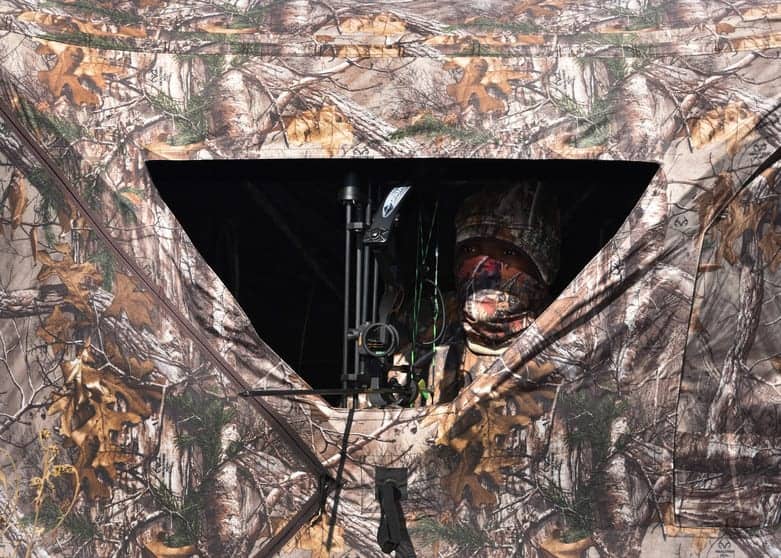As an avid hunter of bucks, I often encounter inquiries regarding the best hunting techniques and the biggest risks associated with them. Given the popularity of ground blinds, one risk that I receive routine inquiries about is whether or not ground blinds can spook deer.
In a nutshell, the bad news is that ground blinds can spook deer for several reasons. Deer are especially sensitive to sight, sound, and scent, which means that the improper use of ground blinds can increase the risk of deer fleeing from your property and going right into your neighbor’s freezer.
However, the good news is that if ground blinds are set up properly and used tactically, they also offer major benefits for hunters, including optimal concealment, that treestands do not.
How Do Ground Blinds Spook Deer?
The use of ground blinds is a popular tactic for ground hunting, which enables hunters to be at “eye level” with their targets. In fact, this hunting technique has been used since prehistoric times, given its general success and effectiveness. Some targets, such as turkeys, require less planning and fewer precautions, whereas other targets, namely bucks, do require more finesse and foresight when it comes to using ground blinds effectively. The reason why deer require a more cautious approach is that these blinds can spook deer for various reasons, many of which depend on the actions and strategies of the hunters themselves.
RELATED: Need Guns or Ammo or BOTH? In Stock Here!<<<
When hunting from the ground, hunters must be especially attuned to their body movements as they are now “eye-level” with the deer they are targeting. Specifically, hunters should be well aware of which parts of their bodies and/or hunting equipment could be visible through the windows of their ground blinds. Deer are very sensitive to sudden movements, which means the unexpected appearance of a hand movement, head movement, or rifle movement through the window of the blind can be more than sufficient to frighten them off, defeating the purpose of effective concealment in the first place. Furthermore, if deer approach the blind closely enough, they can see directly into the blind, which is why the placement of the blind is so critical.
Aside from sudden physical movements, it is critical to remain conscious of any sounds that emit from the ground blind itself. Ground blinds certainly hide sounds more effectively than no encasement at all, but they are not “soundproof.” Several unexpected different sounds can spook deer, including squeaking chairs, clicking the safety off, or just an arrow hitting the rest. I know I’m not the only one who has run their broadhead through their blind in the dark. In addition, if you are hunting with a partner, any conversation or other sounds can also spook deer, including whispering if the deer are close enough.
In addition, while ground blinds do help obscure human odor and other foreign scents to a deer, it is critical to remember that no ground blind is completely “scent proof.” Similar to how sudden, visible movements can spook deer, an unanticipated odor or scent can often make deer edgy enough to flee that particular area and seek another avenue of forestry consumption. As prey, deer have an inherent tendency to sense any potential danger on a continuous basis, and unfamiliar scents equate to possible danger from a deer’s perspective.
Additional Information
That said, the effective use of ground blinds is an excellent strategy for passionate hunters, particularly those who prefer hunting from the ground instead of hunting from trees. Unlike treestands, ground blinds have greater portability, which means it is easier to move them to a different location while still tracking the same target deer. In addition, properly installed ground blinds, coupled with effective hunting tactics, offer superior concealment, particularly in comparison to targeting deer from treestands.
Tips For Installing Ground Blinds Properly
When installing ground blinds, you can address several risks from the onset of its setup, particularly those associated with sight and scent.
In terms of sight, placing a ground blind near the deer trail that runs between feeding and bedding areas is a good place to begin for ground hunting dilettantes, as you will greatly increase the likelihood of spotting various deer. For more experienced hunters, you may have more options regarding the locations for blind placement, given your track record of successful hunting. Regardless of the chosen location, brushing the blind with branches or other foliage will help ensure that the blind blends in more effectively with the scenery, especially if the blind’s edges are obscured. Some hunters argue that the blind is already camouflaged; however, brushing the blind enhances the camouflage, thereby increasing the odds of a successful hunt.
To address possible issues with scent, the blind should be placed in an area that primarily receives the “downwind” side of the trail, which helps ensure that most, if not all, scents are directed away from where the deer are grazing. While the best brands offer the best scent containment, no brand can obscure all odor entirely. For this reason, gauging the wind patterns and projected movements, namely how they will affect the transmission of scent, will be crucial in determining the best location for your blind.
Once the initial setup is complete, including the prerequisite precautions detailed above, you can then contemplate the best tactics for using the ground blinds effectively while hunting.
Tactics for Hunting with Ground Blinds Effectively
Similar to the proper installation of ground blinds, the caveats, or risks, with ground blinds that can spook deer can also be dealt with by developing tactical hunting strategies to reduce the risk of being detected by deer, either through sight, sound, or scent.
In terms of sight, as deer move near the ground blind, be sure to move within your ground blind even more deliberately, or very slowly. Ideally, it would be best to not move at all until deer are distracted with another activity, whether it is eating or looking in a different direction. Whenever feasible, keep as many windows of the blinds closed as possible, which automatically reduces the probability of a deer becoming spooked by a sudden movement within the ground blind.
When it comes to sound reduction, several techniques can help prevent spooking deer. First, be sure to choose a chair that does not squeak, and ensure that it allows you to easily swivel back and forth silently, with minimal effort involved. All gear and equipment should be placed carefully within the ground blind, particularly near metal. Also, if you are hunting with someone, which is one of the many benefits of ground blinds, be sure that both you and your hunting partner remain very silent whenever your targets approach. Don’t be afraid to try all of these scenarios prior to the season starting to see how quiet or loud your movements are.
For scent reduction, I’ve made some recommendations in “Must Have Scent Control Products,” which have facilitated effective scent reduction and hunting success in my experience. Some of the best common practices also include washing all clothing and hunting gear with scent-free cleaners and storing them in sealed containers until you are ready to hunt again.
See my article on Must-Have Scent Control Products to know what works for me.








